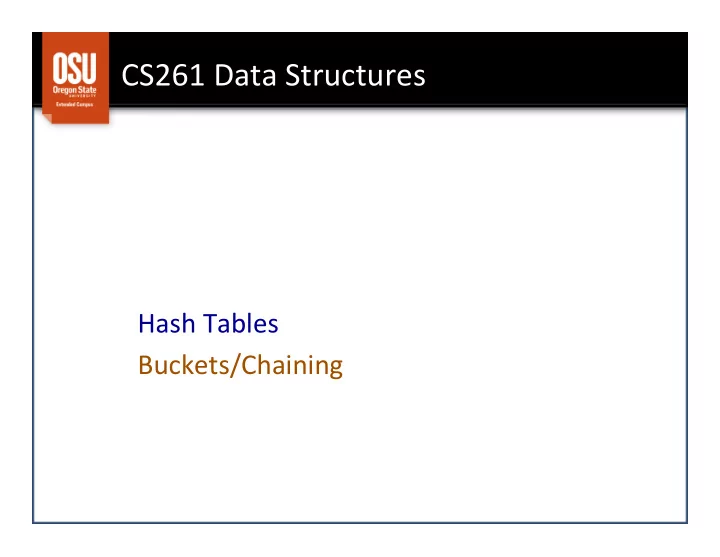

CS261 ¡Data ¡Structures ¡ Hash ¡Tables ¡ Buckets/Chaining ¡
Hash ¡Tables: ¡ Resolving ¡Collisions ¡ There ¡are ¡two ¡general ¡approaches ¡to ¡resolving ¡ collisions: ¡ 1. Open ¡address ¡hashing: ¡if ¡a ¡spot ¡is ¡full, ¡probe ¡for ¡next ¡ empty ¡spot ¡ 2. Chaining ¡(or ¡buckets): ¡keep ¡a ¡collecJon ¡at ¡each ¡table ¡ entry ¡
Resolving ¡Collisions: ¡ Chaining ¡/ ¡Buckets ¡ Maintain ¡a ¡collecJon ¡ (typically ¡a ¡Map ¡ADT) ¡at ¡each ¡table ¡ entry: ¡ ¡ ¡ Each ¡collecJon ¡is ¡called ¡a ¡‘bucket’ ¡or ¡a ¡‘chain’ ¡ 0 ¡ Angie ¡ Robert ¡ ¡ 1 ¡ Linda ¡ ¡ 2 ¡ ¡ Joe ¡ Max ¡ John ¡ 3 ¡ ¡ 4 ¡ ¡ 5 ¡ Abigail ¡ Mark ¡
Hash ¡Table ¡ImplementaJon: ¡ IniJalizaJon ¡ struct ¡HashTable ¡{ ¡ ¡ ¡struct ¡Linked ¡List ¡**table; ¡ ¡ ¡ ¡ /* ¡Hash ¡table ¡ à ¡Array ¡of ¡Lists. ¡*/ ¡ ¡ ¡int ¡ ¡capacity; ¡ ¡ ¡int ¡count; ¡ } ¡ ¡ void ¡initHashTable(struct ¡HashTable ¡*ht, ¡int ¡size) ¡{ ¡ ¡ ¡int ¡i; ¡ ¡ ¡ ¡ht-‑>capacity ¡ ¡= ¡size; ¡ ¡ ¡ht-‑>count ¡ ¡ ¡= ¡0; ¡ ¡ ¡ht-‑>table ¡= ¡malloc(ht-‑>capacity ¡* ¡sizeof(struct ¡LinkedList ¡*)); ¡ ¡ ¡assert(ht-‑>table ¡!= ¡0); ¡ ¡ ¡for(i ¡= ¡0; ¡i ¡< ¡ht-‑>capacity; ¡i++) ¡ht-‑>table[i] ¡= ¡newList(); ¡ } ¡
Hash ¡Table ¡ImplementaJon: ¡ Add ¡ ¡ void ¡addHashTable(struct ¡HashTable ¡*ht, ¡TYPE ¡val) ¡{ ¡ ¡ ¡ /* ¡Compute ¡hash ¡table ¡bucket ¡index. ¡*/ ¡ ¡ ¡int ¡idx ¡= ¡hash(val) ¡% ¡ht-‑>capacity; ¡ ¡ ¡if ¡(idx ¡< ¡0) ¡idx ¡+= ¡ht-‑>capacity; ¡ ¡ ¡ ¡ /* ¡Add ¡to ¡bucket. ¡*/ ¡ ¡ ¡addList(ht-‑>table[idx], ¡val); ¡ ¡ ¡ht-‑>count++; ¡ ¡ ¡ ¡ /* ¡Next ¡step: ¡Reorganize ¡if ¡load ¡factor ¡to ¡large. ¡ ¡ ¡More ¡on ¡ ¡ this ¡later! ¡*/ ¡ } ¡
Hash ¡Table: ¡Contains ¡& ¡Remove ¡ • Contains: ¡find ¡correct ¡bucket ¡using ¡the ¡hash ¡ funcJon, ¡then ¡checks ¡to ¡see ¡if ¡element ¡is ¡in ¡ the ¡linked ¡list ¡ • Remove: ¡if ¡element ¡is ¡in ¡the ¡table ¡(e.g. ¡ contains() ¡returns ¡true, ¡ ¡remove ¡it ¡from ¡the ¡ linked ¡list ¡and ¡decrement ¡the ¡count ¡
Hash ¡Table ¡Size ¡ • Load ¡factor: ¡ # ¡of ¡elements ¡ Load ¡factor ¡ λ ¡= ¡ n ¡/ ¡ m ¡ Size ¡of ¡table ¡ – Load ¡factor ¡represents ¡average ¡number ¡of ¡elements ¡ in ¡each ¡bucket ¡ – For ¡chaining, ¡load ¡factor ¡can ¡be ¡greater ¡than ¡1 ¡ • To ¡maintain ¡good ¡performance: ¡if ¡load ¡factor ¡ becomes ¡larger ¡than ¡some ¡fixed ¡limit ¡ (say, ¡8) ¡ à ¡ double ¡table ¡size ¡
Hash ¡Table ¡ ¡ • Load ¡factor: ¡ # ¡of ¡elements ¡ Load ¡factor ¡ λ ¡/ ¡ m = ¡ n ¡ ¡ Size ¡of ¡table ¡ – The ¡average ¡number ¡of ¡links ¡traversed ¡in ¡successful ¡ searches, ¡S, ¡and ¡unsuccessful ¡searches, ¡U, ¡is ¡ S ≈ λ U ≈ λ ¡ ¡ 2 – If ¡load ¡factor ¡becomes ¡larger ¡than ¡some ¡fixed ¡limit ¡ (say, ¡8) ¡ à ¡double ¡table ¡size ¡
Hash ¡Tables: ¡ Algorithmic ¡Complexity ¡ • Assuming: ¡ – Time ¡to ¡compute ¡hash ¡funcJon ¡is ¡constant ¡ – Chaining ¡uses ¡a ¡linked ¡list ¡ – Worst ¡case ¡analysis ¡ à ¡All ¡values ¡hash ¡to ¡same ¡ posiJon ¡ – Best ¡case ¡analysis ¡ à ¡Hash ¡funcJon ¡uniformly ¡ distributes ¡the ¡values ¡ ¡and ¡no ¡collisions ¡ • Contains ¡operaJon: ¡ – Worst ¡case ¡for ¡chaining ¡ à ¡O( ¡ ¡ ¡) ¡ n ¡ ¡ ¡ – Best ¡case ¡for ¡chaining ¡ à ¡O( ¡ ¡ ¡) ¡ 1 ¡ ¡ ¡
Hash ¡Tables ¡With ¡Chaining: ¡ Average ¡Case ¡ • Assume ¡hash ¡funcJon ¡distributes ¡elements ¡uniformly ¡ (a ¡BIG ¡ if) ¡ • And ¡we ¡have ¡ collisions ¡ • Average ¡case ¡for ¡all ¡operaJons: ¡O( λ ) ¡ ¡and ¡ λ ¡= ¡n/m ¡= ¡O(m)/m ¡= ¡O(1) ¡ • Want ¡to ¡keep ¡the ¡load ¡factor ¡relaJvely ¡small ¡ • Resize ¡table ¡ (doubling ¡its ¡size) ¡if ¡load ¡factor ¡is ¡larger ¡than ¡some ¡ fixed ¡limit ¡ (e.g., ¡8) ¡ – Only ¡improves ¡things ¡ IF ¡hash ¡funcJon ¡distributes ¡values ¡ uniformly ¡ – How ¡do ¡we ¡handle ¡a ¡resize? ¡
Design ¡Decisions ¡ • Implement ¡the ¡Map ¡interface ¡to ¡store ¡values ¡ with ¡keys ¡(ie. ¡implement ¡a ¡dicJonary) ¡ • Rather ¡than ¡store ¡linked ¡lists, ¡build ¡the ¡linked ¡ lists ¡directly ¡ – ¡ ¡ ¡ ¡ ¡Link ¡ ¡**hashTable; ¡
Your ¡Turn ¡ • Worksheet ¡38: ¡Hash ¡Tables ¡using ¡Buckets ¡
Recommend
More recommend